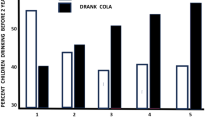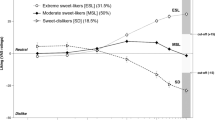Abstract
Background:
Increased preference for fat and sugar may have a role in overweight and obesity development. However, this effect is likely to vary across different food cultures. To date, few studies on this topic have been conducted in children and none have employed an international, multi-centre design.
Objective:
To document taste preferences for fat and sweet in children from eight European countries and to investigate their association with weight status and dietary habits.
Design:
A total of 1696 children aged 6–9 years from survey centres in Italy, Estonia, Cyprus, Belgium, Sweden, Germany, Hungary and Spain tasted and subsequently chose between a high- versus a low-fat cracker and a natural versus a sugar-sweetened apple juice. Children's consumption frequency of fatty and sweet foods and demographic variables were obtained from parental-reported questionnaires. Weight and height of the children were measured.
Results:
Fat and sweet taste preferences varied substantially across survey centres. Independent of survey centre, age, sex, parental education and parental BMI, overweight including obesity was positively associated with fat preference and sweet preference. Fat preference associations were stronger in girls. Girls—but not boys—with a combined preference for fat and sweet had an especially high probability of being overweight or obese. Adjusted models with BMI z-score as the dependent variable were consistent with results of the analyses with BMI categories, but with significant results only for fat preference in girls. Frequent consumption of fatty foods was related to fat preference in bivariate analyses; however, adjusting for survey centre attenuated the association. Sweet preference was not related to consumption of sweet foods, either in crude or in adjusted analyses.
Conclusions:
Fat and sweet taste preferences are related to weight status in European children across regions with varying food cultures.
This is a preview of subscription content, access via your institution
Access options
Subscribe to this journal
Receive 12 print issues and online access
$259.00 per year
only $21.58 per issue
Buy this article
- Purchase on Springer Link
- Instant access to full article PDF
Prices may be subject to local taxes which are calculated during checkout


Similar content being viewed by others

References
Siri-Tarino PW, Sun Q, Hu FB, Krauss RM . Saturated fat, carbohydrate, and cardiovascular disease. Am J Clin Nutr 2010; 91: 502–509.
FAO. Fats and Oils in Human Nutrition: Report of a Joint FAO/WHO Expert Consultation. FAO: Rome, 1994.
Gerber M . Background review paper on total fat, fatty acid intake and cancers. Ann Nutr Metab 2009; 55: 140–161.
Melanson EL, Astrup A, Donahoo WT . The relationship between dietary fat and fatty acid intake and body weight, diabetes, and the metabolic syndrome. Ann Nutr Metab 2009; 55: 229–243.
Rodríguez G, Sjöberg A, Lissner L, Moreno LA . Food patterns and nutrient intake in relation to childhood obesity. In: Moreno LA, Pigeot I, Ahrens W (eds). Epidemiology of Obesity in Children and Adolescence—Prevalence and Etiology. Springer: New York, 2011.
van Baak MA, Astrup A . Consumption of sugars and body weight. Obes Rev 2009; 10 (Suppl 1): 9–23.
Lissner L, Heitmann BL . Dietary fat and obesity: evidence from epidemiology. Eur J Clin Nutr 1995; 49: 79–90.
Drewnowski A, Greenwood MR . Cream and sugar: human preferences for high-fat foods. Physiol Behav 1983; 30: 629–633.
Drewnowski A . Taste preferences and food intake. Annu Rev Nutr 1997; 17: 237–253.
Johnson PM, Kenny PJ . Dopamine D2 receptors in addiction-like reward dysfunction and compulsive eating in obese rats. Nat Neurosci 2010; 13: 635–641.
Glanz K, Basil M, Maibach E, Goldberg J, Snyder D . Why Americans eat what they do: taste, nutrition, cost, convenience, and weight control concerns as influences on food consumption. J Am Diet Assoc 1998; 98: 1118–1126.
Mela DJ, Sacchetti DA . Sensory preferences for fats: relationships with diet and body composition. Am J Clin Nutr 1991; 53: 908–915.
Bartoshuk LM, Duffy VB, Hayes JE, Moskowitz HR, Snyder DJ . Psychophysics of sweet and fat perception in obesity: problems, solutions and new perspectives. Philos Trans R Soc Lond B Biol Sci 2006; 361: 1137–1148.
Drewnowski A, Brunzell JD, Sande K, Iverius PH, Greenwood MR . Sweet tooth reconsidered: taste responsiveness in human obesity. Physiol Behav 1985; 35: 617–622.
Raynor HA, Polley BA, Wing RR, Jeffery RW . Is dietary fat intake related to liking or household availability of high- and low-fat foods? Obes Res 2004; 12: 816–823.
Drewnowski A, Kurth CL, Rahaim JE . Taste preferences in human obesity: environmental and familial factors. Am J Clin Nutr 1991; 54: 635–641.
Cooling J, Blundell JE . High-fat and low-fat phenotypes: habitual eating of high- and low-fat foods not related to taste preference for fat. Eur J Clin Nutr 2001; 55: 1016–1021.
Nakamura K, Shimai S, Kikuchi S, Tanaka M . Correlation between a liking for fat-rich foods and body fatness in adult Japanese: a gender difference. Appetite 2001; 36: 1–7.
Kelder SH, Perry CL, Klepp KI, Lytle LL . Longitudinal tracking of adolescent smoking, physical activity, and food choice behaviors. Am J Public Health 1994; 84: 1121–1126.
Birch LL . Development of food preferences. Annu Rev Nutr 1999; 19: 41–62.
Dietz WH . Critical periods in childhood for the development of obesity. Am J Clin Nutr 1994; 59: 955–959.
Ricketts CD . Fat preferences, dietary fat intake and body composition in children. Eur J Clin Nutr 1997; 51: 778–781.
Wardle J, Guthrie C, Sanderson S, Birch L, Plomin R . Food and activity preferences in children of lean and obese parents. Int J Obes Relat Metab Disord 2001; 25: 971–977.
Fisher JO, Birch LL . Fat preferences and fat consumption of 3- to 5-year-old children are related to parental adiposity. J Am Diet Assoc 1995; 95: 759–764.
Hill C, Wardle J, Cooke L . Adiposity is not associated with children's reported liking for selected foods. Appetite 2009; 52: 603–608.
Ahrens W, Bammann K, de Henauw S, Halford J, Palou A, Pigeot I et al. Understanding and preventing childhood obesity and related disorders--IDEFICS: a European multilevel epidemiological approach. Nutr Metab Cardiovasc Dis 2006; 16: 302–308.
Ahrens W, Bammann K, Siani A, Buchecker K, De Henauw S, Iacoviello L et al. The IDEFICS cohort: design, characteristics and participation in the baseline survey. Int J Obes (Lond) 2011; 35: S3–S15.
Bammann K, Peplies J, Sjöström M, Lissner L, De Henauw S, Galli C et al. Assessment of diet, physical activity and biological, social and environmental factors in a multi-centre European project on diet- and lifestyle-related disorders in children (IDEFICS). J Public Health 2006; 14: 279–289.
Knof K, Lanfer A, Bildstein MO, Buchecker K, Hilz H . Development of a method to measure sensory perception in children at European level. Int J Obes (Lond) 2011; 35: S131–S136.
Guinard J-X . Sensory and consumer testing with children. Trends in Food Science & Technol 2000; 11: 273–283.
Léon F, Couronne T, Marcuz MC, Köster EP . Measuring food liking in children: a comparison of non verbal methods. Food Quality and Preference 1999; 10: 93–100.
Liem DG, Mars M, de Graaf C . Consistency of sensory testing with 4- and 5-year-old children. Food Quality and Preference 2004; 15: 541–548.
Suling M, Hebestreit A, Peplies J, Bammann K, Nappo A, Eiben G et al. Design and results of the pretest of the IDEFICS study. Int J Obes 2011; 35 (Suppl 1): S30–S44.
Cole TJ, Bellizzi MC, Flegal KM, Dietz WH . Establishing a standard definition for child overweight and obesity worldwide: international survey. BMJ 2000; 320: 1240–1243.
Cole TJ, Flegal KM, Nicholls D, Jackson AA . Body mass index cut offs to define thinness in children and adolescents: international survey. BMJ 2007; 335: 194.
Kuczmarski RJ, Ogden CL, Guo SS, Grummer-Strawn LM, Flegal KM, Mei Z et al. 2000 CDC Growth Charts for the United States: Methods and Development. CDC: Atlanta, 2002.
Lanfer A, Hebestreit A, Ahrens W, Krogh V, Sieri S, Lissner L et al. Reproducibility of food consumption frequencies derived from the Children's Eating Habits Questionnaire used in the IDEFICS study. Int J Obes (Lond) 2011; 35: S61–S68.
Huybrechts I, Boernhorst C, Pala V, Moreno LA, Barba G, Lissner L et al. Evaluation of the Children's Eating Habits Questionnaire used in the IDEFICS study by relating urinary calcium and potassium to milk consumption frequencies among European children. Int J Obes (Lond) 2011; 35: S69–S78.
Willett W . Nutritional Epidemiology. 2nd edn. Oxford University Press: New York, 1998.
UNESCO. International Standard Classification of Education ISCED 1997. UNESCO Institute for Statistics: Montreal, 2006.
Drewnowski A, Kurth C, Holden-Wiltse J, Saari J . Food preferences in human obesity: carbohydrates versus fats. Appetite 1992; 18: 207–221.
Salbe AD, DelParigi A, Pratley RE, Drewnowski A, Tataranni PA . Taste preferences and body weight changes in an obesity-prone population. Am J Clin Nutr 2004; 79: 372–378.
USDA/ORC Marco. Developing Effective Wording and Format Options for a Children's Nutrition Behavior Questionnaire for Mothers of Children in Kindergarten. USDA: Washington, 2005.
Acknowledgements
This work was done as part of the IDEFICS Study (http://www.idefics.eu). We gratefully acknowledge the financial support of the European Community within the sixth RTD Framework Programme Contract No. 016181 (FOOD). Additionally, the first author acknowledges the financial contribution from the German Academic Exchange Service (DAAD) and the Hans-Böckler-Stiftung.
Author information
Authors and Affiliations
Consortia
Corresponding author
Ethics declarations
Competing interests
The authors declare no conflict of interest.
Rights and permissions
About this article
Cite this article
Lanfer, A., Knof, K., Barba, G. et al. Taste preferences in association with dietary habits and weight status in European children: results from the IDEFICS study. Int J Obes 36, 27–34 (2012). https://doi.org/10.1038/ijo.2011.164
Received:
Revised:
Accepted:
Published:
Issue Date:
DOI: https://doi.org/10.1038/ijo.2011.164
Keywords
This article is cited by
-
Associations of parental feeding practices with children’s eating behaviors and food preferences: a Chinese cross-sectional study
BMC Pediatrics (2023)
-
Effects of weight change on taste function; a systematic review
Nutrition Journal (2023)
-
Influences of genetics, lifestyle and environment on obese and non-obese university students in Malaysia
Journal of Public Health (2021)
-
Glucagon-like peptide-1, a matter of taste?
Reviews in Endocrine and Metabolic Disorders (2021)
-
Determinants of Physical Fitness in Children with Repaired Congenital Heart Disease
Pediatric Cardiology (2021)


